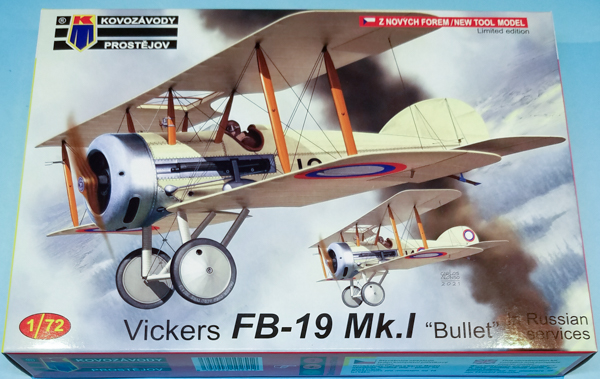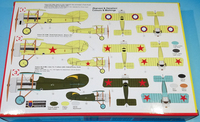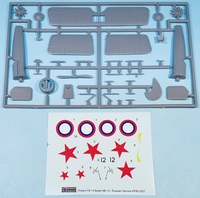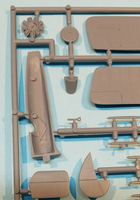
Kovozávody Prostějov 1/72 Vickers FB-19 Mk.I "Bullet" In Russian Services
By Matt Bittner
Introduction
Taken from Wikipedia:
"The Vickers F.B.19 was a British single-seat fighting scout of the First World War, developed from the Barnwell Bullet prototype, and sometimes known as the Vickers Bullet. It served with the Royal Flying Corps and the Imperial Russian Air Service, which subsequently led to the Red Air Force adopting it during the Russian Civil War."
"Around sixty-five F.B.19s were built. Six early production examples were sent to France in late 1916 for operational evaluation, where the RAF found them unsuitable for the fighting conditions then evolving. Twelve Mk IIs went to the Middle East, five to Palestine and seven to Macedonia; no squadron was fully equipped with the type. They were not popular. A few Mk IIs served as trainers and for air defense over London, but the type had effectively been retired before the end of 1917.
"The F.B.19 found more favour in Russia, where it was known as the Vikkers Bullit. A single example was initially sent for evaluation in 1916. Leading pilots, including the ace Yevgraph Kruten, regarded it favourably. Russian sources indicate that it was fitted with a more powerful 130-hp Clerget engine that provided a maximum speed of around 200 km/h, making the Bullit faster than both the SPAD S.VII and the Sikorsky S-20. The Russians procured around twenty or thirty planes, and deployed at least four to front-line units, including one in which the ace Grigoriy Suk claimed two of his victories. A number of unarmed planes served as trainers.
"After the October Revolution, a number of Bullits found their way into Bolshevik hands. A force of six F.B.19s are said to have been employed in 1918 against the anti-Bolshevik People's Army, and the type remained in service until 1924.
"All examples of the F.B.19s active in Russian service appear to have been Mk. I planes with unstaggered wings. A number of additional examples are said to have remained in crates on the dockside at Archangelsk until the British Royal Navy destroyed them during the evacuation of the allied expeditionary force in 1919."
The Kit
The Kovozávody Prostějov (KP) 1/72 Vickers FB-19 Mk.I "Bullet" In Russian Services consists of 32 pieces of gray, injected plastic. Decals are for three Russian F.B.19s:
- Black 12, pilot Grigory E. Suk, originating from Russo-Czech family, Imperial Russian Air Force 1917 (overall in Clear Doped Linen (CDL) fabric surfaces, yellow-painted wood surfaces with a natural metal cowl and metal nose panels)
- Russian Red Air Force, Moscow 1921 (finished as above)
- No. 112, 11th Fighter Air Detachment, 4th Air Division, Russian Air Force 1920 (finished with green upper surfaces, light blue lower surfaces and what I think is aluminum doped wood and fabric areas of the nose, along with a natural metal cowl)

|
Decals appear to be in register and are decent. I built the KP D.500 and had issues with its decals, so until I can build this, use caution when dealing with KP decals.
Three important items. First, some will think the exterior molded-on detail is a bit overdone. All that needs, though, is a careful pass of a sanding stick to tone it down. Second, the instructions are for all three boxings of the F.B.19 KP has released. Since the Russians only flew the Mk.I (and not the Mk.II) it's important to note which instruction steps are for the Mk.I versus the Mk.II. The third item is that according to Wikipedia the Russians used 130 hp Clerget engines in their F.B.19s. Since the kit only provides the 100 hp Gnome and the 110 hp Clerget you'll need to source a 130 hp Clerget on your own. Small Stuff produces an engine that can be built as either the 110 hp or the 130 hp Clerget.
Naturally construction starts with the cockpit and it's decent enough. There are no seat belts nor instrument panel decals and while the detail is nice enough, it's a bit spartan. But I'm having difficult finding interior references for the F.B.19 so unsure of what it should look like. The kit provides a floor, seat, control stick, rudder pedals and an instrument panel with a few raised details. Unfortunately the cockpit sides have a mold release plug right on some of the molded-in side detail, so care must be taken to remove these without destroying the detail.

|
Once the cockpit is assembled and everything painted, then it can be inserted into one fuselage half and the halves glued together. The next instruction step has you add the flying surfaces and while it shows the engine and cowl glued on, those actually aren't added until step 4.
Now Step 4 comes into play and here is where you add the engine, cowl, gun on the port-side of the fuselage and headrest. I would definitely leave all of the above off - except the headrest - until final assembly.

|
Next you add the upper wing. Since this is a Mk.I there is no kit surgery needed. If you were to build the Mk.II then KP has you remove 1mm from the center struts. Why KP couldn't provide a separate set of struts I'll never know.
The last part of construction is gluing the landing gear pieces together and adding that to the model, along with the prop, wheels and tail skid. Thankfully, the last page of the instructions has rigging diagrams for both Marks.
Conclusion
I have learned, building their D.500, that the truth lies in the building of a KP model. While the detail tends to be nicely done on KP kits, where you'll need your modeling mojo is in the building. Still, it's nothing that's truly insurmountable. Thankfully KP appear to be tackling the "unusual" WWI aircraft in injected plastic, which is nice.
I definitely thank Kovozávody Prostějov for sending the "Vickers Bullet" to review.
